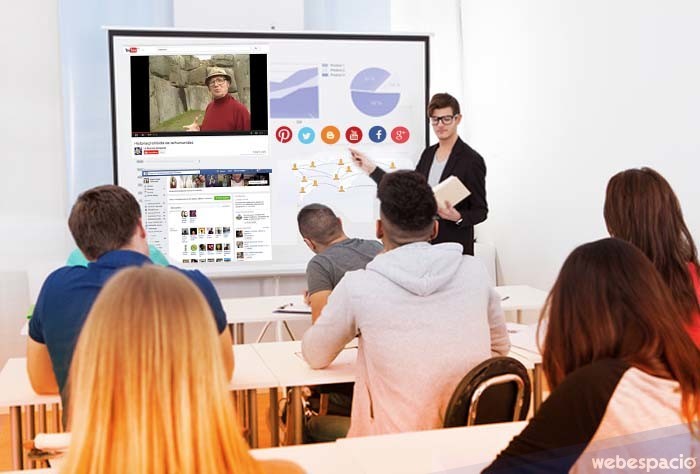REDES SOCIALES EN EL AULA
Una de las herramientas que tiende a utilizarse en el aula son las redes sociales. Y, a pesar de que presentan algunas desventajas e inconvenientes, su introducción en el aula es positiva porque favorecen la apertura hacia la sociabilidad y la participación en grupos.

Las redes sociales son una herramienta positiva para la socialización, pero siempre supervisada por tutores. Y, dentro de las redes sociales, la red por excelencia es Facebook, una de las más utilizadas en España. Sus posibilidades de uso son diversas. Por ejemplo, se pueden crear grupos en Facebook para que los alumnos puedan chatear con el profesor, publicar contenidos interesantes relacionados con la asignatura, plantear preguntas…, entre otras funciones como, por ejemplo, la creación de un grupo por parte de los alumnos para practicar idiomas. Aparte, los padres pueden seguir también lo que hacen sus hijos en el aula y las tareas que tienen que realizar.
Un potencial que próximamente se va a incrementar con el reciente anuncio de la nueva herramienta de Facebook para entrar de lleno en las aulas: Grupos para Escuelas(Groups for Schools), en la que cada centro educativo podrá disponer de un grupo en el que sus miembros, siempre que tengan una cuenta de correo electrónico activa de ese centro, podrán formar parte de esa comunidad para conocer las noticias de actualidad del centro, agenda, acceder a recursos formativos, compartir vídeos y fotos y apuntes u otros documentos de utilidad para las asignaturas o debatir. Además, Facebook, recientemente, ha rediseñado su Centro de Seguridad para las Familias para incluir información dirigida exclusivamente a profesores para su uso en el aula TIC sin tener que utilizar perfiles personales por parte de los estudiantes ni de los profesores.
Muy útil también es Twitter. En este caso, se puede acceder y compartir información actual de forma rápida y sencilla, teniendo a disposición enlaces a contenidos de interés como artículos, entrevistas o informes, entre otros materiales, aparte de poder hacer un seguimiento de un tema específico a través del sistema de búsqueda. Otras utilidades de Twitter en el aula son su empleo como canal de comunicación más directo y rápido con el profesor y estudiantes y con alumnos o docentes de otros centros o instituciones, además de poder subir archivos, trabajos, deberes, presentaciones, monografías… a través de aplicaciones como Scribb, Slideshare o Twitdoc y de ser utilizada para debatir haciendo uso de un hashtag. Pero, además, Twitter también fomenta la capacidad de síntesis, al tener que utilizar tan sólo los 140 caracteres, y desarrolla actitudes positivas al lograr seguidores y permite construir una red de contactos para interactuar con profesionales del medio y líderes de opinión con los que los alumnos pueden entablar conexiones para obtener información, consejos
Y, por supuesto, tampoco puede faltar en las redes sociales YouTube. En este caso, se dispone de un apartado específico de Youtube para Escuelas (YouTube for Schools) para su uso en los centros educativos, que permite el acceso a vídeos de distintas materias formativas, de manera que se impide el visionado de otros vídeos no educativos. Los vídeos a los que se accede pertenecen a unas listas de vídeos que están agrupadas y por materiales como matemáticas o lengua, que forman parte de Youtube EDU, un canal que está específicamente diseñado para contenidos educativos.
También son muy útiles desde el punto de la formación redes profesionales como LinkedIn a través de los grupos, que tienen la finalidad de poner en contacto a profesionales con intereses similares para que intercambien experiencias e información sobre temas de interés o novedades que puedan ser útiles para el desarrollo de la carrera profesional. De esta manera, según explican desde LinkedIn, cada usuario puede buscar por la palabra que le interese para seleccionar los grupos relacionados con ese tema a los que podrá sumarse y compartir artículos o enlaces de vídeo y otros contenidos interesantes, además de generar discusión entre todos sus miembros y participar en ella. También se facilita información sobre grupos de temas similares.
En los siguientes links se puede encontrar más información:
Propuestas para utilizar redes sociales en el aula: http://www.aulaplaneta.com/2015/04/08/recursos-tic/ocho-propuestas-para-utilizar-las-redes-sociales-en-el-aula/
Redes sociales educativas:
http://www.educaciontrespuntocero.com/recursos/redes-sociales-educativas/25272.html
Proyecto DISCO: http://digitalschools.eu/es/
One of the tools that tends to be used in the classroom are social networks. And, although they present some disadvantages, their introduction in the classroom is positive because they favor openness towards sociability and participation in groups.
Social networks are a positive tool for socialization, but always supervised by tutors. And, within social networks, the network par excellence is Facebook, one of the most used in Spain. Its possibilities of use are diverse. For example, you can create groups on Facebook so that students can chat with teachers, publish interesting content related to the subject, ask questions …, among other functions, such as the creation of a group by students to Practice languages. In addition, parents can also follow what their children do in the classroom and the tasks they have to do.
A potential that will soon increase with the recent announcement of the new Facebook tool to enter fully into the classrooms: Groups for Schools, in which each educational center will have a group in which its Members, as long as they have an active e-mail account of that center, they can be part of that community to know the current news of the center, agenda, access to training resources, share videos and photos and notes or other useful documents for Subjects or discuss. In addition, Facebook has recently redesigned its Family Safety Center to include information aimed exclusively at teachers for use in the ICT classroom without having to use personal profiles on the part of students or teachers.
Also useful is Twitter. In this case, you can access and share current information quickly and easily, having links to interesting content such as articles, interviews or reports, among other materials, besides being able to track a specific topic through the system Of search. Other uses of Twitter in the classroom are its use as a channel of communication more direct and fast with the teacher and students and with students or teachers from other centers or institutions, in addition to being able to upload files, papers, presentations, monographs … through Of applications like Scribb, Slideshare or Twitdoc and to be used to debate using a hashtag. But, in addition, Twitter also fosters the ability to synthesize, having to use only 140 characters, and develops positive attitudes to achieve followers and builds a network of contacts to interact with media professionals and opinion leaders with whom Students can make connections for information, advice…
And, of course, you can not miss on YouTube social networks. In this case, a specific section of YouTube for Schools (YouTube for Schools) is available for use in schools, which allows access to videos of different training subjects, so that other non-educational videos are prevented from viewing . The videos that are accessed belong to a list of videos that are grouped and by materials such as mathematics or language, which are part of Youtube EDU, a channel that is specifically designed for educational content.
They are also very useful from the point of formation professional networks like LinkedIn through the groups, that have the purpose of putting in contact with professionals with similar interests so that they exchange experiences and information on topics of interest or novelties that may be useful for The development of the professional career. In this way, as explained from LinkedIn, each user can search for the word that interests you to select groups related to that topic to which you can join and share articles or video links and other interesting content, and generate discussion among all Its members and participate in it. Information is also provided on similar topic groups.
In the following links you can find more information:
Proposals to use social networks in the classroom: http://www.aulaplaneta.com/2015/04/08/recursos-tic/ocho-projetos-para-utilizar-las-redes-sociales-en-el-aula/
Social educational networks: http://www.educaciontrespuntocero.com/recursos/redes-sociales-educativas/25272.html
Proyect DISCO: http://digitalschools.eu/es/
Xema
Latest posts by Xema (see all)
- e- Learning vs b- Learning - 01/06/2017
- TICs EN LA OFICINA - 24/05/2017
- TRELLO COMO HERRAMIENTA EN LA OFICINA - 23/05/2017




Recomiendo: Roberto Cuadros-Muñoz y Javier Villatoro (eds.): Twitter en la enseñanza y aprendizaje del español, Málaga, Digitalingua, 2014. Texto completo, en acceso abierto, en http://digitalingua.net/ediciones/twitter/